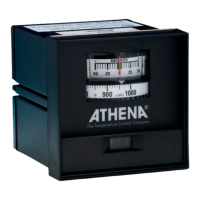7
Thermocouple
Wiring Circuits
Use thermocouple and extension wire that conforms to the
appropriate thermocouple type specified on the serial number
tag. In thermocouple circuits, the negative lead is colored red.
Extension wires must be of sufficient size so that on long runs
the thermocouple circuit resistance does not exceed 100
ohms.
Do not run thermocouple leads in the same conduit as the
power lines. If shielded thermocouple wire is used, terminate
the shield only at the controller end using the corner screw
provided for that purpose.
Standard Thermocouples
I.S.A. Type Materials Color Code
(U.S.A.)
J Iron-Constantan (I/C) White (+)/Red(-)
K Chromel-Alumel (C/A) Yellow (+)/Red (-)
T Copper-Constantan Blue (+)/Red (-)
RTD Wiring
Circuits
Thermocouple
Placement
The 2002 and 3220 units are designed for 100 ohm platinum
RTDs. Two-wire RTDs are connected to terminals -1 and -2
with a jumper connecting 2 to 3. Keep leads short and use
heavy gauge copper extension wires if necessary, to minimize
lead resistance. For long runs 3-wire RTD should be used and
wire gauge should be sufficient that resistance does not
exceed 10 ohms.
DO NOT RUN RTD LEADS IN THE SAME CONDUIT AS POWER LINES.
If shielded RTD wire is used, terminate the shield only at the
controller end, using the corner screw provided for that pur-
pose.
Proper thermocouple placement can eliminate many prob-
lems in the system. The probe should be placed so that it can
detect any temperature change with little thermal lag. In a
process that requires fairly constant heat output, the probe
should be placed close to the heater. In processes where the
heat demand is variable, the probe should be close to the
work area. Some experimenting with probe location can often
provide optimum results.
In a bath process, the addition of a stirrer will help to eliminate
lags. Since the thermocouple is basically a point measuring
device, putting more than one thermocouple in parallel will
provide an average temperature reading and produce better
results in air-heated processes.
NOTE: RTDs
tend to be shock
sensitive and
require extra care
in handling and
installation

